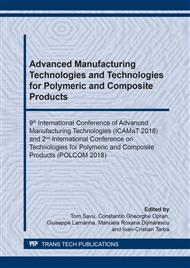[1]
K.L. Reifsneider Ed., Fatigue of Composite Materials, Elsevier New York (1990) 231-237.
Google Scholar
[2]
Vassilopuolos A.P., Keller T., Fatigue of Fiber-Reinforced Composites, (2011) Springer.
Google Scholar
[3]
S. Haojiea, Y. Weixingb, W. Yitaoa, Synergistic damage mechanic model for stiffness properties of early fatigue damage in composite laminates, Procedia Engineering 74 (2014) 199–209.
DOI: 10.1016/j.proeng.2014.06.250
Google Scholar
[4]
DOT/FAA/AR-10/6 (2011) http://www.tc.faa.gov/its/worldpac/techrpt/ar10-6.pdf.
Google Scholar
[5]
R.D.B. Sevenois, D. Garoz, F.A. Gilabert, S.W.F. Spronk, W. Van Paepegem, Microscale based prediction of matrix crack initiation in UD composite plies subjected to multiaxial fatigue for all stress ratios and load levels, Composites Science and Technology Volume 142 (2017) 124–138.
DOI: 10.1016/j.compscitech.2017.02.004
Google Scholar
[6]
G. Caprino, A. D'Amore, Flexural fatigue behaviour of random continuous-fibre-reinforced thermoplastic composites, Composites, Composites Science and Technology, 58 (1998) 957-965.
DOI: 10.1016/s0266-3538(97)00221-2
Google Scholar
[7]
L. Sartore, A. D'Amore, L. Di Landro, Ethylene vinyl acetate blends with cellulosic fillers and reinforcements, Polymer Composites 36 (2015) 980-986.
DOI: 10.1002/pc.23471
Google Scholar
[8]
D'Amore A, Verde P., Modeling the flexural fatigue behavior of glass-fiberreinforced thermoplastic matrices, Mechanics of Time-Dependent Materials, 17 (1) (2013) 15-23.
DOI: 10.1007/s11043-012-9192-y
Google Scholar
[9]
A. D'Amore, M. Giorgio, L. Grassia, Modeling the residual strength of carbon fiber reinforced composites subjected to cyclic loading, International Journal of Fatigue 78 (2015) 31–37.
DOI: 10.1016/j.ijfatigue.2015.03.012
Google Scholar
[10]
Alberto D'Amore, Luigi Grassia, Angelo Ceparano, Procedia Engineering 167 (2016) 97 – 102.
Google Scholar
[11]
D'Amore, A . Grassia, L., Phenomenological approach to the study of hierarchical damage mechanisms in composite materials subjected to fatigue loadings, Composite Structures 175 (2017) 1-6.
DOI: 10.1016/j.compstruct.2017.04.071
Google Scholar
[12]
Alberto D'Amore, Luigi Grassia, Mechanics of Time-Dependent Materials, 20 (1) (2017) 1-6.
Google Scholar
[13]
Grassia L, D'Amore A, Verde P, On The Inter-Conversion Between Viscoelastic Material Functions of Polycarbonate, Aip Conference Proceedings, 1459 (2012) 375.
DOI: 10.1063/1.4745714
Google Scholar
[14]
Grassia L, D'Amore A, Calculation of the shrinkage-induced residual stress in a viscoelastic dental restorative material, Mechanics of Time-Dependent Materials, 17 (1) (2013) 1-13.
DOI: 10.1007/s11043-012-9190-0
Google Scholar
[15]
Liguo Zhao, Nick A Warrior, Andrew C Long, 16th International Conference on Composite Materials (2007) Kyoto, Japan.
Google Scholar
[16]
L. Grassia and A. D'Amore, Macromol. Symp. 228 (2005) 1-15.
Google Scholar
[17]
F. de Angelis, D. Cancellara, L. Grassia, A. D'Amore. Mechanics of Time-Dependent Materials.
DOI: 10.1007/s11043-017-9375-7
Google Scholar
[18]
Lange J., Toll S. and Månson J-A.E.. Polymer, 36 (1995) 3135-3141.
Google Scholar
[19]
Flores F., Gillespie J.W. and Bogetti T.A.. Polymer Eng. and Science, 42 (2002) 582-590.
Google Scholar
[20]
L. Sartore, F. Bignotti, S. Pandini, A. D'Amore, L. Di Landro, Polymer Composites 37 (2015) 3416-3422.
DOI: 10.1002/pc.23541
Google Scholar
[21]
Nimmer R.P.. Journal of Composites Technology and Research, 12 (1990) 65-75.
Google Scholar
[22]
Wisnom M.R.. Journal of Composite Materials, 24 (1990) 707-726.
Google Scholar
[23]
A. D'Amore, L. Grassia, Mechanics of Time-Dependent Materials 20 (2016) 1–12.
Google Scholar
[24]
L. Grassia and A. D'Amore, On the interplay between viscoelasticity and structural relaxation in glassy amorphous polymers, Journal of Polymer Science: Part B: Polymer Physics 47 (2009) 724–739.
DOI: 10.1002/polb.21675
Google Scholar
[25]
L. Grassia, A. D'Amore, Aip Conference Proceedings.
DOI: 10.1063/1.4745713
Google Scholar
[26]
D'Amore A, Grassia L, Verde P, Modeling the fatigue behavior of glass fiber reinforced thermoplastic and thermosetting matrices, Aip Conference Proceedings, 1459 (1) (2012) 372-374.
DOI: 10.1063/1.4745713
Google Scholar
[27]
Aghdam M.M., Smith D.J. and Pavier M.J., Journal of the Mechanics and Physics of Solids, 48 (2000) 499-528.
Google Scholar
[28]
A. D'Amore, F. Caputo, L. Grassia, M. Zarrelli, Numerical evaluation of structural relaxation-induced stresses in amorphous polymers, Composites: Part A, 37 (2006) 556–564.
DOI: 10.1016/j.compositesa.2005.05.011
Google Scholar
[29]
M. Zarrelli, I. Partridge, A. D'Amore, Warpage induced in bi-material specimens: Coefficient of thermal expansion, chemical shrinkage and viscoelastic modulus evolution during cure, Composites: Part A, 37 (2006) 565–570.
DOI: 10.1016/j.compositesa.2005.05.012
Google Scholar
[30]
P. G. de Gennes, Glass, The European Physical Journal E, 201-205, (2000).
Google Scholar
[31]
G. Reiter, P.G. DeGennes, Eur. Phys. J. E, 6 (2001) 25-28.
Google Scholar
[32]
P.A. O'Connell and G.B. McKenna, Science, 307 (2005).
Google Scholar
[33]
William J. Orts, John H. van Zanten, Wen-li Wu, and Sushil K. Satija. Phys. Rev. Lett. 71 (1993) 867.
Google Scholar
[34]
T. Kanaya, T. Miyazaki, H. Watanabe, K. Nishida, H.Yamano, S. Tasaki, D.B. Bucknall, Polymer, 44 (2003) 3769-3773.
DOI: 10.1016/s0032-3861(03)00309-4
Google Scholar
[35]
M. Mukherjee, M. Bhattacharya, M. K. Sanyal, Th. Geue, J. Grenzer, U. Pietsch, Physical Review E, 66 (2002) 061801.
Google Scholar
[36]
Rosa M., Grassia L., D'Amore A., D'Escamard A., Enthalpy Relaxation of Polystyrene at Different Molecular Weight Using Fast Calorimetry, Procedia Engineering 167 (2016) 265-269.
DOI: 10.1016/j.proeng.2016.11.696
Google Scholar
[37]
J.L. Keddie, R.A.L. Jones, R.A. Cory, Faraday Discuss. Chem. Soc. 98 (1994) 219.
Google Scholar
[38]
J.S. Sharp, J.A. Forest, Phys. Rev. E, 67 (2003) 031805.
Google Scholar
[39]
J.A. Forest, K. Dalnoky-Veress, J.R. Stevens, J.R. Dutcher, Phys. Rew. Letter 77 (1996) (2002).
Google Scholar
[40]
J. A. Forrest, KK. Dalnoki-Veress, J. R. Dutcher, Physical Review E, 56 (1997) 5705-5716.
Google Scholar
[41]
J. S. Sharp, J. A. Forrest, Physical Review Letters, 91 (2003) 235701-1.
Google Scholar
[42]
K. Dalnoki-Veress, J. A. Forrest, C. Murray, C. Gigault, J. R. Dutcher, Physical Review E, 63 (2001) 031801.
Google Scholar
[43]
J. Mattsson, J. A. Forrest, L. Borjesson, Physical Review E, 62 (2000) 5187-5200.
Google Scholar
[44]
Grassia, L. and D'Amore A., Constitutive law describing the phenomenology of subyield mechanically stimulated glasses, Physical Review E 74 (2006) 021504.
DOI: 10.1103/physreve.74.021504
Google Scholar
[45]
M. Fraldi, A. Cutolo, L. Esposito, A. D'Amore, Mech. Time-Dependent Materials 21 (2017) 45-59.
Google Scholar
[46]
Grassia, L. and D'Amore A., The relative placement of linear viscoelastic functions in amorphous glassy polymers, Journal of Rheology, 53 (2) (2009) 339-356.
DOI: 10.1122/1.3056631
Google Scholar


